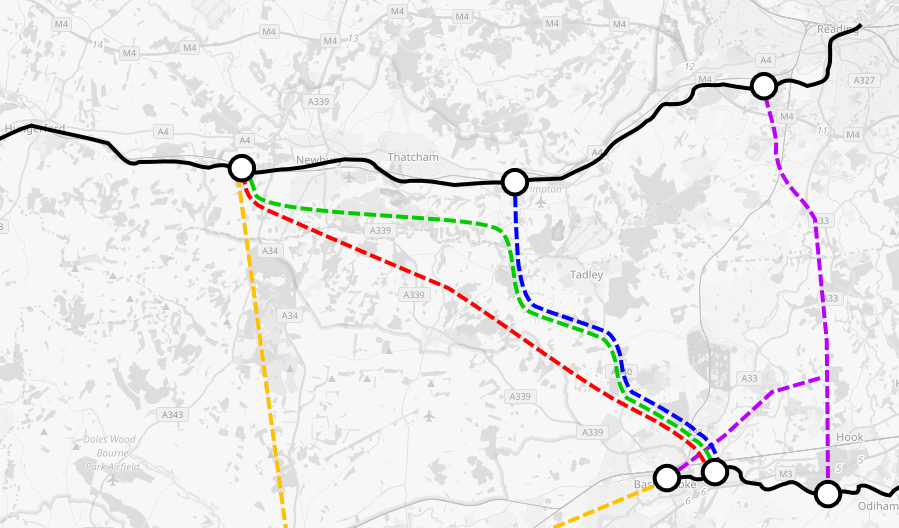Berks and Hants Canal
The Berks and Hants Canal, incorporated as the Berkshire and Hampshire Junction Canal Company,[1] was a proposed (but unbuilt) canal in the English counties of Berkshire and Hampshire. Proposals for the waterway originate after the completion of the Kennet and Avon Canal and the Basingstoke Canal in the 1790s, with a view to connecting the two canals.
| Berks and Hants Canal | |
|---|---|
| Specifications | |
| Length | 13 miles (21 km) |
| Locks | 12 (plus inclined plane at Sherborne St John) |
| Status | Rejected by Parliament |
| History | |
| Original owner | Berkshire and Hampshire Canal Company |
| Principal engineer | Francis Giles |
| Other engineer(s) | John Rennie |
| Date of act | 1790s (rejected) 1825 (rejected) 1826 (rejected) |
| Geography | |
| Start point | Midgham, Berkshire |
| End point | Old Basing, Hampshire |
| Connects to | Kennet and Avon Canal Basingstoke Canal |
| Berks and Hants Canal | |||||||||||||||||||||||||||||||||||||||||||||||||||||||||||||||||||||||||||||||||||||||||||||||||||||||||||||||||||||||||||||||||||||||||||||||||||||||||||||||||
|---|---|---|---|---|---|---|---|---|---|---|---|---|---|---|---|---|---|---|---|---|---|---|---|---|---|---|---|---|---|---|---|---|---|---|---|---|---|---|---|---|---|---|---|---|---|---|---|---|---|---|---|---|---|---|---|---|---|---|---|---|---|---|---|---|---|---|---|---|---|---|---|---|---|---|---|---|---|---|---|---|---|---|---|---|---|---|---|---|---|---|---|---|---|---|---|---|---|---|---|---|---|---|---|---|---|---|---|---|---|---|---|---|---|---|---|---|---|---|---|---|---|---|---|---|---|---|---|---|---|---|---|---|---|---|---|---|---|---|---|---|---|---|---|---|---|---|---|---|---|---|---|---|---|---|---|---|---|---|---|---|---|
| |||||||||||||||||||||||||||||||||||||||||||||||||||||||||||||||||||||||||||||||||||||||||||||||||||||||||||||||||||||||||||||||||||||||||||||||||||||||||||||||||
Proposals
The first proposal was put forward at a meeting of the Kennet and Avon Canal Company on 7 February 1794 by Mr Best of Basingstoke.[2] Best proposed a junction on the Kennet and Avon Canal near Hamstead Marshall, linking to the Basingstoke Canal at Old Basing.[2]
A later suggestion for connecting the waterways was tabled by Ralph Dodd in the early 1800s, who suggested a link to Basingstoke from the Andover Canal near Fullerton, with a divergent canal at Whitchurch to Hamstead Marshall.[2][3]
A third proposal was made by the Kennet and Avon Canal Company in the 1810s, which was surveyed by John Rennie. Rennie recommended a 21-mile (34 km) canal from Hamstead Marshall to Old Basing, via Brimpton and Tadley. Browning Hill, to the south of Tadley near Baughurst, would have been traversed on its north side by a 0.85-mile (1.37 km) tunnel, with portals near the Baughurst turnpike (at Axmansford) to the west and near St Peter's Church to the east.[4] A short flight of locks would have taken the canal south out of the Kennet Valley before crossing the river Enborne near Shalford Bridge. A further three locks would have lifted the canal out of the Enborne valley to the south of Brimpton.[5] By following contours on the 10-mile (16 km) section between Brimpton and Basingstoke, the length of the summit pound of the Basingstoke canal would have been increased to 30 miles (48 km).[5] This proposal was opposed by the Thames authorities,[2] and was likely met with opposition from the Basingstoke Canal company.[5]
Rennie died in 1821. Three years later, his proposal was amended by his junior, Francis Giles, who surveyed a similar but shorter route totalling 13 miles (21 km). Rather than diverging from the Kennet and Avon to the west of Newbury, Giles's route left the Kennet and Avon Canal between Midgham Lock and Heale's Lock, running south to Brimpton before meeting with Rennie's route. The proposal would have used a shorter tunnel of 0.5 miles (0.80 km) at Tadley, as well as the potential for an inclined plane at Sherborne St John.[2] Giles's proposal had aqueducts over the River Enborne, the Bow Brook and the River Loddon, and totalled 38 bridges and approximately 12 locks. The summit of the canal would have been 100 feet (30 m) above the lowest points, and with no nearby watercourses to provide water, significant pumps would have been required to ensure sufficient water on the summit pound and through any subsequent locks. The project was met with financial support totalling over £70,000 (equivalent to £5,182,000 in 2015), although the proposed cost of the construction was £105,000 (equivalent to £7,773,000 in 2015) and the majority of local landowners opposed the plans.[6] A meeting at The Hind's Head in Aldermaston was held in January 1825 to rally for the opposition of the canal. When the bill reached parliamentary sessions, it was rejected by Parliamentary Committee.[7] He made an amendment the following year to provide a pumping station by the River Enborne at Ashford Hill, although this resubmitted bill was rejected in 1826.[2]
With the Basingstoke Canal un-navigable beyond the fallen Greywell Tunnel, the Basingstoke Canal Society are proponents of a canal linking the two waterways. However, rather than a route via Tadley, a due-north canal connecting Greywell with the Kennet and Avon between Burghfield and Southcote Locks is suggested.[8]

References
- "Berkshire & Hampshire Junction Canal Co". National Archives. Retrieved 16 November 2016.
- Norgate, Martin. "Hampshire Canals". Hampshire Maps. University of Portsmouth. Retrieved 16 November 2016.
- "Southampton and Salisbury Canal". Local Waterways. Southampton Canal Society. Retrieved 16 November 2016.
- "Basingstoke Canal News". Basingstoke Canal. Surrey and Hampshire Canal Society. Retrieved 16 November 2016.
- "Basingstoke Canal News". Basingstoke Canal. Surrey and Hampshire Canal Society. Retrieved 16 November 2016.
- "Project News" (PDF). Tadley and District History Society (12): 2–3. 2007. Retrieved 16 November 2016.
- Shead, Jim. "Hants & Berks Junction Canal project". Jim Shead's Waterways Information. Retrieved 16 November 2016.
- Shanks, Craig. "The Last 5 Miles (and the link to the Kennet and Avon canal)". The Basingstoke Canal Society. Retrieved 16 March 2017.